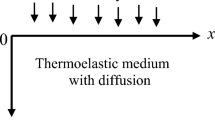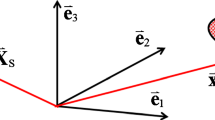Summary
In part I of the present work a constitutive theory is established for a gas diffusing, as a dilute solution, in a linear thermoelastic solid. The theory is compatible with the laws of thermomechanics i.e., mass, momentum and energy balance, as well as with the principles of positive entropy production and material objectivity. The assumptions of small concentrations of the gas and the absence of viscous effects simplify the analysis considerably. This allows a thermomechanical model for the solid to be assumed, independent of the presence of the gas. The constitutive model adopted for the solid is the linear uncoupled theory of thermoelasticity. In this level of generality a transport theory is developed for the gas by using the conservation laws of mass, linear momentum and internal energy. Some uncommon identities for the thermodynamic quantities of the gas are also established, based on the derived functional dependence for the internal energy, entropy, free energy and stress tensor of the gas. Thus a Gibb's type equation is obtained. In addition a comparison with classical irreversible thermodynamics, previous intuitive theories and experiments is made.
Zusammenfassung
In Teil I der vorliegenden Arbeit wird eine Materialtheorie für ein diffundierendes Gas, als verdünnte Lösung, in einen linear thermoelastischen Festkörper angegeben. Die Theorie ist mit den Gesetzen der Thermomechanik verträglich. Die Voraussetzung kleiner Gaskonzentrationen und das Fehlen viskoser Effekte vereinfachen die Analysis beträchtlich. Das erlaubt weiter die Annahme eines thermomechanischen Modells für den Festkörper unabhängig vom Vorhandensein des Gases. Als Modell für den Festkörper wird die lineare entkoppelte Theorie der Thermoelastizität herangezogen. Für das Gas wird eine Transporttheorie unter Verwendung des Massenerhaltungssatzes, des Impulssatzes und der inneren Energie entwickelt. Einige unübliche Identitäten für die thermodynamischen Größen des Gases werden angegeben, basierend auf der Funktionalabhängigkeit der inneren Energie, der Entropie, der freien Energie und dem Spannungstensor des Gases. Daraus wird eine Gibbsche Gleichung erhalten. Zusätzlich wird ein Vergleich mit der klasischen irreversiblen Thermodynamik, sowie früheren intuitiven Theorien und Experimenten gemacht.
Similar content being viewed by others
References
Aifantis, E. C., Gerberich, W. W.: Gaseous Diffusion in a Stressed-Thermoelastic Solid, I: The Thermomechanical Formulation. Acta Mechanica28, 1–24 (1977).
Aifantis, E. C., Gerberich, W. W.: Diffusion of Gases in Linear Elastic Stress Fields, Effect of Hydrogen on Behavior of Materials. Proceedings of an International Conference, AIME, Wyoming1975, 350–354.
Oriani, R. A.: Hydrogen in Metals, Fundamental Aspects of Stress Corrosion Cracking. Nat. Assoc. Corros. Engr., Houston, Texas45, 32–50 (1969).
Van Leeuwen, H. P.: A Quantitative Model of Hydrogen Induced Grain Boundary Cracking. J. of Corrosion, NACE29, 197–204 (1973).
Shewmon, P. G.: Diffusion in Solids. New York: McGraw-Hill. 1963.
Boley, B. A., Weiner, J. H.: Theory of Thermal Stresses. New York: J. Wiley. 1967.
Sokolnicoff, I. S.: Mathematical Theory of Elasticity. New York: McGraw-Hill. 1963.
Haar, D., Wergeland, H.: Elements of Thermodynamics. Reading, Mass.: Addison-Wesley. 1966.
Truesdell, C., Toupin, R. A.: The Classical Field Theories. (Handbuch der Physik, III/1.) Berlin-Göttingen-Heidelberg: Springer. 1960.
Truesdell, C.: Mechanical Basis for Diffusion. J. of Chem. Phys.27, 2336–2344 (1962).
Bowen, R. M., Wiese, J. C.: Diffusion in Mixtures of Elastic Materials. Intl. J. Engr. Sci.7, 689–722 (1969).
McGregor, R.: Diffusion and Sorption in Fibres and Films, Vol. 1. London: Academic Press. 1974.
Bockris, J. O'M., et al.: The Effect of Stress on the Chemical Potential of Hydrogen in Iron and Steel. Acta Metallurgica19, 1209–1218 (1971).
Bockris, J. O'M., Subramamyan, P. K.: A Thermodynamic Analysis of Hydrogen in Metals in the Presence of an Applied Stress Field. Acta Metallurgica19, 1205–1208 (1971).
Hirschfelder, J. O., Curtiss, C. F., Bird, R. M.: Molecular Theory of Gases and Liquids New York: J. Wiley. 1954.
Meixner, J., Reik, H. G.: Thermodynamik der irreversiblen Prozesse. (Handbuch der Physik, III/2.) Berlin-Göttingen-Heidelberg: Springer. 1959.
Gyarmati, I.: Non-Equilibrium Thermodynamics. New York-Heidelberg-Berlin: Springer. 1970.
Fung, Y. C.: Foundations of Solid Mechanics. London: Prentice-Hall. 1965.
Author information
Authors and Affiliations
Rights and permissions
About this article
Cite this article
Aifantis, E.C., Gerberich, W.W. Gaseous diffusion in a stressed-thermoelastic solid. Part II: Thermodynamic structure and transport theory. Acta Mechanica 28, 25–47 (1977). https://doi.org/10.1007/BF01208786
Received:
Issue Date:
DOI: https://doi.org/10.1007/BF01208786




